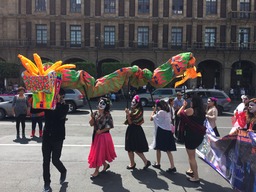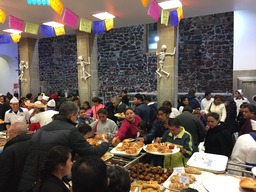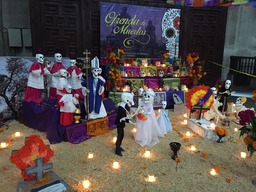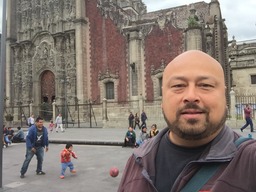
Day of the Dead/
Dragon Dance Parade
 Day of the Dead/ Dragon Dance Parade |
Death is roaming the streets of the capital.
It promenades through the streets: in the guise of young women who have masked themselves with makeup to transform their faces into skulls. It stands on street corners: in the guise of young men toting crucifices and long, lone figurines of Christ. It appears as a pastel-colored sugar skull in a pastry-shop window.
Day of the Dead has arrived.
Despite the morbid cause for celebration the manifestations of the holiday are anything but grim. People are handing out candy. Some of the skull-painted women have made up only half of their faces: I saw one whose painted-on eye socket formed not a rounded, open cavity but a black, petal-lined flower. Another ignored the skeletal theme altogether by choosing simply to make herself up as a cat with whiskers, black snout, and pair of pointed ears set upon a hairband to cap off her costume.
 Pasteleria Ideal |
Previous times I've visited Mexico City I'd neglected one of its prime attractions: the Templo Mayor. I don't think I'd been aware of its archaeological significance nor had I realized how centrally located it was right in the heart of the Zócalo. (Which forms the very axis of the universe according to those who constructed the temples, there.)
 Day of the Dead Diorama - Catedral Metropolitana |
"The nine-banded armadillo called 'ayotochtli' in Nahuatl which means 'rabbit turtle'."
I'm sure that armadillos, rabbits, and turtles must all be categorized under entirely different species. But, somehow calling the animal a "rabbit-turtle" rather than an "armadillo" sounds so much appropriate. (Which reminded me of the Chinese name for "panda," 熊貓 xiongmao, which literally means "bear-cat". Neither a bear not a cat... but somehow a better-suited name for the particular creature.)
Another informational sign within the temple ruins was entitled Serpents and Frogs at the Great Temple. Part of it read:
 David at Center of Aztec Universe Catedral Metropolitana at Zócalo |
Did the Aztecs actually put blue clothing onto frogs before cooking them up? I double-checked the parallel Spanish description to be certain. My language ability here is pretty basic, but the line "las ranas eran vestiads de azul, para después ser sacrificados y asadas" seemed to indicate that yes, frogs were indeed dressed up and eaten as part of a pre-Columbian festival.
I'm enjoying the present festivities all around me. But, I'd definitely stay longer if I knew there were to be another holiday celebrated by dressing up frogs in blue and barbecuing them.
Next stop: Mazatlán